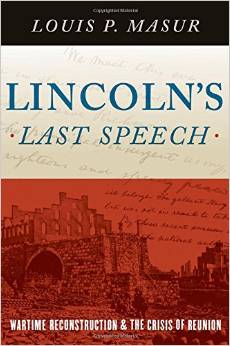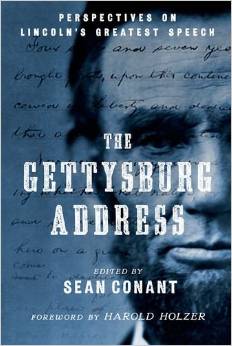Lincoln’s Last Speech: Wartime Reconstruction and the Crisis of Reunion by Louis P. Masur. Oxford University Press, 2015. Cloth, IBSN: 978-0190218393. $24.95.
 It has long been observed that scholarly works devoted to particular writings or speeches by Abraham Lincoln—let alone his life or career as a whole—have themselves become a cottage industry. In his recent addition to Oxford University Press’s “Pivotal Moments in American History” Series, Louis P. Masur, whose previous book was a study of the Emancipation Proclamation, examines, as the new book’s title indicates, Lincoln’s “last speech.” This speech, delivered on the evening of April 11, 1865, would prove to be Lincoln’s last public address before his assassination, although Lincoln’s untimely death gave the speech a finality it did not have at the time Lincoln delivered it. The address was prompted by Robert E. Lee’s surrender two days earlier, but its topic was not a triumphalist celebration of Union victory, as many people were expecting. Instead, Lincoln took the occasion to deliver a disquisition on the problem of “Reconstruction” and, more specifically, to issue a defense of the loyal government for Louisiana that he had helped to establish during the war, despite that government’s failure to guarantee black suffrage and racial equality. Historians of Reconstruction have always taken a small measure of pride in the fact that the last words Lincoln ever spoke in public were devoted to Reconstruction.
It has long been observed that scholarly works devoted to particular writings or speeches by Abraham Lincoln—let alone his life or career as a whole—have themselves become a cottage industry. In his recent addition to Oxford University Press’s “Pivotal Moments in American History” Series, Louis P. Masur, whose previous book was a study of the Emancipation Proclamation, examines, as the new book’s title indicates, Lincoln’s “last speech.” This speech, delivered on the evening of April 11, 1865, would prove to be Lincoln’s last public address before his assassination, although Lincoln’s untimely death gave the speech a finality it did not have at the time Lincoln delivered it. The address was prompted by Robert E. Lee’s surrender two days earlier, but its topic was not a triumphalist celebration of Union victory, as many people were expecting. Instead, Lincoln took the occasion to deliver a disquisition on the problem of “Reconstruction” and, more specifically, to issue a defense of the loyal government for Louisiana that he had helped to establish during the war, despite that government’s failure to guarantee black suffrage and racial equality. Historians of Reconstruction have always taken a small measure of pride in the fact that the last words Lincoln ever spoke in public were devoted to Reconstruction.
Masur uses this speech as a window onto the problem of “wartime Reconstruction”: the effort to organize loyal governments in the seceded states, to restore those states to the Union, and, after the Emancipation Proclamation had been issued, to abolish slavery during the war. Masur’s title, however, is slightly misleading—although this observation is not meant as a criticism. The problem is a built-in one. Masur’s book, its title notwithstanding, is not devoted exclusively to what Abraham Lincoln thought about Reconstruction, even though the evolution of Lincoln’s views on Reconstruction looms large in Masur’s analysis. Rather, as the subtitle indicates, Masur uses Lincoln’s last speech to explore the broader problem of “Wartime Reconstruction and the Crisis of Reunion.” Seen this way, Lincoln’s approach to Reconstruction was but one among many.
To be sure, any analysis of Lincoln’s approach to Reconstruction—and there are many—would have to place it within its larger context and contrast it with the other approaches. Masur does not focus on Lincoln’s approach per se, but he ingeniously uses the last speech to provide an organizational framework for exploring the problem of wartime Reconstruction. He employs particular phrases or passages from the speech as chapter titles and, more importantly, as the analytical theme of each chapter. Thus, while Lincoln’s “last speech” indeed explored the problem of Reconstruction, and, moreover, while any analysis of “wartime Reconstruction” by definition would have to devote considerable attention to Lincoln, Masur is less concerned with Lincoln’s views on Reconstruction than he is with how wartime Reconstruction anticipated in many ways the difficulties of postwar Reconstruction. Still, a “what-might-Lincoln-have-done” quality inevitably permeates the analysis.
Masur uses a wide array of primary source materials, and he succeeds in constructing a succinct and coherent narrative. (The complexities of wartime Reconstruction can sometimes make even the specialist’s head spin.) Masur does not necessarily put forward a particular thesis or interpretive argument, instead laying out the multiplicity of viewpoints of people at the time—in particular those of Northerners, southern Unionists, and African Americans (since the large majority of white Southerners had no interest in Reconstruction). In so far as Masur deals with Lincoln in particular, he observes, quite correctly, that Lincoln used the terms “restoration,” “Reconstruction,” and “reunion” almost interchangeably, making it difficult to track how his views on Reconstruction shifted over time. Many contemporaries, both radical and conservative, clearly distinguished between “restoration” (merely restoring the antebellum status quo, with no dramatic changes to political or economic relations or institutions) and “Reconstruction” (changes in these things, to varying degrees), but Lincoln did not. Consequently, when Lincoln discussed Reconstruction, he sometimes meant restoration of the seceded states and sometimes the genuine reconstruction of southern society. Despite this difficulty in terminology, Masur could perhaps have made this distinction a bit clearer.
Neither does Masur attempt to situate his analysis, particularly regarding Lincoln, within the considerable historiography on the topic. This strategy is fine, since the book is presumably designed for a general audience or for undergraduate course adoption. Following the story is difficult enough without also having to keep track of what various historians say. Still, Masur might have given a brief nod to the existing scholarship on Lincoln, especially since he emphasizes the traditional view of Lincoln’s intended “leniency” toward the former Confederates and accentuates the conflict between Lincoln and the Radical Republicans. There is no disputing Lincoln’s opposition to anything that smacked of vindictiveness once the war ended. But recent scholarship on Lincoln and on wartime Reconstruction has called into question the importance of the differences between Lincoln and the Radicals. Andrew Johnson certainly made Lincoln look much better to his Radical critics, and Masur correctly observes that it is easy to see Lincoln as more radical in hindsight than he was at the time. Yet the Radical Republicans were motivated by more than a desire to punish the white South, while scholars from LaWanda Cox to Peyton McCrary to, more recently, James Oakes and Eric Foner have underscored the extent to which Lincoln by the end of his life had begun to think seriously about the meaning of emancipation for American political and economic life. Lincoln may not have realized it by April 11, 1865, but Masur’s own analysis suggests that Lincoln’s desire for a speedy restoration based on leniency and mercy for ex-Confederates would likely have come into conflict with his hope for a substantive Reconstruction based on justice and a meaningful freedom for the former slaves.
But admittedly, this is the realm of speculation. Masur has provided an engaging, accessible, and cogent overview of an endlessly fascinating, complicated, and important topic. It would be hard to think of a better brief introduction to the problem of wartime Reconstruction.
John C. Rodrigue is Lawrence and Theresa Salameno Professor of History at Stonehill College and the author of Lincoln and Reconstruction (2013).

